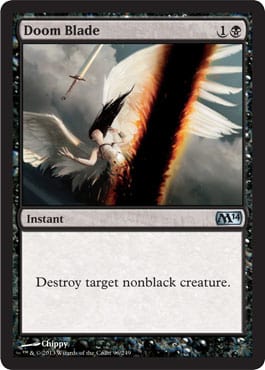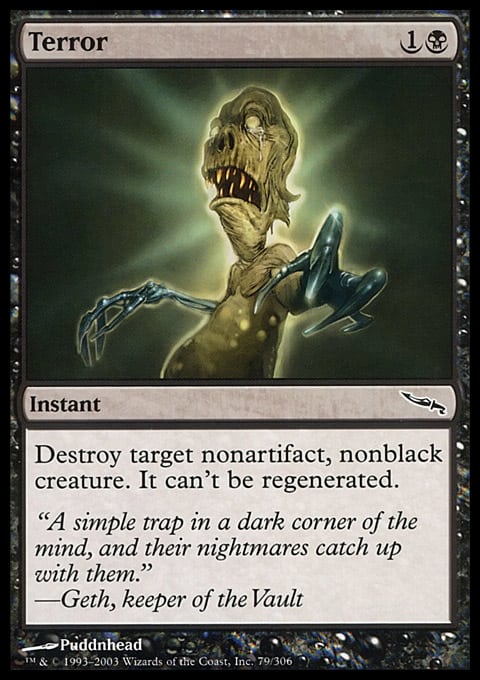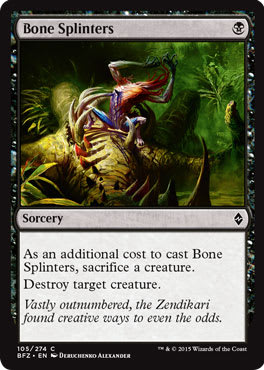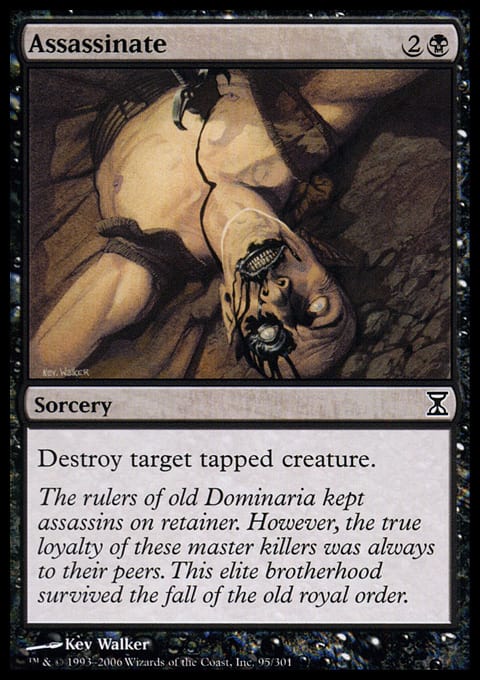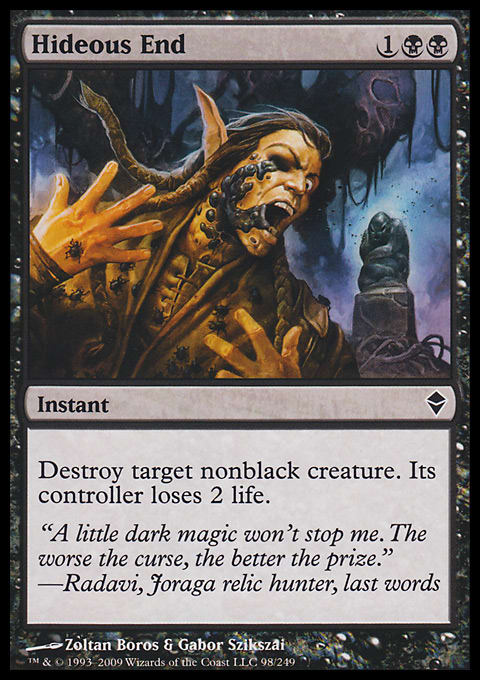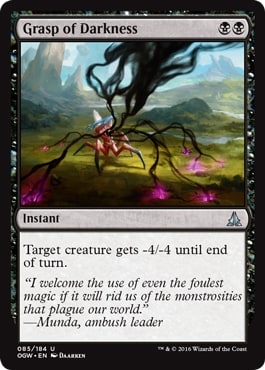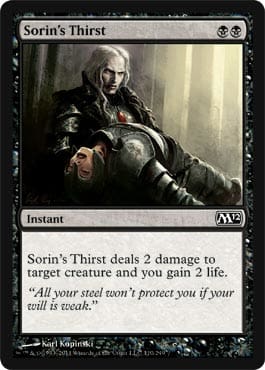“Removal isn’t as good as it used to be.”
“Wizards is nerfing the game in favor of creatures.”
“Remember when everything died to Doom Blade?”
One of the secrets to Magic’s longevity is there are a number of different ways to approach it. it’s surely no coincidence I majored in history back in college because I often enjoy watching the ebb and flow of the game as it develops over time. What’s good now? Why was this card good (or bad) back then? What do these cards mean in the greater narrative tale of the game of Magic: the Gathering?
The period of time we’re in right now, on the cusp of a new set, is perhaps the best time to ask these questions, because a new chapter in the game has just been revealed. There is plenty for folks to get excited about in Eldritch Moon, whether you’ve been riveted by the unfolding story or simply focus on the game instead of the lore, and here on Gathering Magic we’ve been busy highlighting lots of the different aspects and elements of this newest set.
For my part, the question I’ve been wondering is, “where does Eldritch Moon fit?” The history of Magic is like a tapestry with countless interwoven threads, each representing narratives ranging from the grand and overarching, to the subtle and almost invisible. Some of the former include the reception and success of different sets, and the pendulum swing of the game’s power level. For instance, the high of Urza’s Saga gave way to the low of Mercadian Masques, or Mirrodin into Champions of Kamigawa.
Much of Eldritch Moon’s story has yet to be written, and the quill will begin to inscribe the page of history once players have the opportunity to purchase the cards. Will the set sell well? Will it impact the tournament formats? What will catch fire around the kitchen tables of the world? But today, as we look at what Eldritch Moon offers us, we’re going to tug on one strand of this tapestry. One vitally important, but relatively small and specific strand: Black removal.
Now, it’s obvious there are a number of different elements that rise and fall, grow and evolve from set to set. We could, for instance, take a look at Blue’s card drawing, Green’s creatures, or Red’s burn; and, someday perhaps we will. But Black removal is equally iconic from the day the first person opened a Terror in their Alpha booster pack, and killed their first creature with it. Creature efficiency has, as a whole, risen over time, so it’s only natural to look for ways to deal with creatures as one bellwether for a set’s power.
What I find most intriguing about removal, aside from the visceral delight in destroying an opponent’s cherished creature, is the story it tells of its environment. Every set features a mix of new cards and reprints all designed to do this simple task, and yet the incredible variety of effect and spectrum of ‘power’ tells a much more intricate story.
I look to Shards of Alara as the demarcation point of the modern era, which is where I’ll begin. I choose Shards because that was where the Intro Pack was introduced, rising from the ashes of the Theme Deck (perhaps someday many years from now, I’ll be writing about some new ‘modern era’ beginning with Kaladesh, where the Planeswalker Deck emerged from the ashes of the Intro Pack). Along the way I’ll be highlighting certain cards and archetypes we’ll see over and over again, and that are crucial in understanding the greater design philosophy behind Black removal. And by ‘removal,’ I’ll be limiting our look to cards with a single impact (as opposed to ‘sweepers’, cards that hit all creatures in play, as those are quite different). We’ll also be considering commons and uncommons only, as the higher rarities cards don’t necessarily have the same impact on theme and power level of a set given their infrequency.
Over time, we’ll see how Wizards tinkers with certain knobs and levers, giving us something new each time, even when that something new might appear to be something old. These knobs and levers include:
- Mana cost. Although one of the most obvious of a card’s characteristics, this remains one of the most important to the notion of “playability”
- Dedication. Related to mana cost, how much Black mana do you have to have at your disposal to reliably cast the card? Can you splash the card, or do you need to be heavily in Black?
- Speed. When can the card be played? During our main phases only (slow), or during an opponent’s turn as well (fast)?
- Versatility. What can this card deal with? While ultimately the answer is “creatures,” the selection can widely very. Big creatures? Small creatures? Expensive creatures? Cheap creatures? Creatures of particular colors?
- Additional effect. Once upon a time Stone Rain existed. Wizards determined that this was an unfun and imbalanced strategy, but rather than remove it from the game, they moved the cost to where it would be adjudged ‘fairer’ (see: Craterize) or tacked on added effects that pushed the cost up (see: Poison the Well). What sort of riders have these removal cards been given?
Shards of Alara Block (2008-09)
Shards of Alara was a multicolored set that introduced the concept of the “shard,” a three-color combination consisting of an anchoring, central color and its two allied colors (we wouldn’t see the opposite, a “wedge,” for another six years). The removal of Shards reflected the different nature of the five Shards. Bone Splinters was very Grixis, in both theme and gameplay. Its effect was simple and unconditional, “destroy target creature,” but the cheap mana cost was offset with a condition very reminiscent of the lethal world it evoked: you had to sacrifice a creature as well.
Shards also brought us artifact-based removal for the artifact-laden shard of Esper, in the Executioner's Capsule, more Grixis-themed removal in Agony Warp (which offered some versatility in exchange for the two-color component), and finally a -4/-4 mode in the Grixis Charm. This highlights an important distinction we’ll see again and again today, the difference between outright destruction, killing through toughness debuffing (-X/-X effects), and direct damage.
Conflux moved things along with Drag Down, which tied into the domain mechanic, Wretched Banquet, and the very flavorful Yoke of the Damned. Interestingly, none of these effects are especially easy to achieve, instead making us ask that all-important question: what does this card want me to do? For Drag Down, that meant playing multicolored decks, and the more colors the merrier. Wretched Banquet asked us to play larger creatures over smaller ones, while Yoke is a “hoop card,” one which asks us to meet certain conditions in exchange for getting the effect we want at a cheaper cost.
The conclusion of the block was the all-multicolored Alara Reborn, and here we were treated to fully exploring what Black removal would look like when mixed with other colors. Look at the symmetry of the spells Bituminous Blast and Deny Reality. Each have exactly the same converted mana cost, with one needing Red and the other Blue (Black’s allied colors). Both offer cascade. And both offer removal characteristic of that allied color: burn for Red, bounce for Blue.
Sangrite Backlash evokes Agony Warp in that it mixes a power boost with a toughness debuff. And finally, the crown jewel of the block: Terminate. Terminate is exceptional, checking off many of the right boxes. It’s 2-mana, instant speed, and hits nearly anything. The downside is that it has a high dedication cost, requiring you to be in two specific colors (Red and Black). But for those looking for cheap removal, it did the trick. And then Magic 2010 came along.
Magic 2010 (2009)
This was the first of the “modern core sets,” a concept which has just found its conclusion in last year’s Magic Origins and appeared to draw inspiration for its naming convention off of the auto industry. Rather than being white-bordered releases of reprints every other year, the revamped core set concept envisioned an annual release, with lots of new cards and reasons to get excited about a core set that had not been seen before. The old dictum, “core sets were what you bought when they were out of the other stuff” no longer applied.
Magic 2010 brought a host of Black removal that would be seen time and again in subsequent sets. Assassinate was essentially Death Stroke, redone with the “take away one colored mana and replace it with![]() ” principle. Consume Spirit and Tendrils of Corruption rewarded you for playing heavily in Black, while Deathmark was a sideboard staple. Weakness offered the stat debuff option, but the enduring legacy of Magic 2010 is surely Doom Blade.
” principle. Consume Spirit and Tendrils of Corruption rewarded you for playing heavily in Black, while Deathmark was a sideboard staple. Weakness offered the stat debuff option, but the enduring legacy of Magic 2010 is surely Doom Blade.
Doom Blade set a standard that still endures to this day. It was the go-to removal spell of its kind, a reputation cemented by its longevity (it would not leave the Core Set environment until Murder replaced it in Magic 2013). For those who weren’t active players at the time, it is hard to overstate the card’s importance; creatures were assessed on whether or not they “die to Doom Blade.”
But just like the example offered above of Stone Rain, Wizards would eventually come to regard Doom Blade as a little “too good,” even with the non-Black restriction, and subsequent cards would see their power level toned down.
Zendikar Block (2009-10)
Zendikar introduced a very fast Limited environment with a strong tribal element, and the removal shows it. The most expensive removal card from the first set was Hideous End, which was a variant Doom Blade that cost more, but offered an added effect. It’s important to note that the extra cost of Hideous End was![]() , so this wasn’t simply a cost increase of “one more mana” (though that’s certainly how it appears), it was also a dedication cost.
, so this wasn’t simply a cost increase of “one more mana” (though that’s certainly how it appears), it was also a dedication cost.
Zendikar also brought us the Vampire-tribal Feast of Blood, Disfigure, and Mire Blight. Mire Blight evoked the conditional enchantment feel we saw in Yoke of the Damned, and Disfigure offered a small stat debuff, just right for an environment teeming with smaller, faster creatures.
Although Worldwake was a smaller set, it brought even more to the table than Zendikar did. While Smother was a reprint, it was another card tailored for its environment. Tomb Hex followed the Death Stroke/Assassinate pattern, being a version of Disfigure that had a landfall component to help reinforce the set’s mechanic. Speaking of Disfigure, a more potent version (with corresponding pricetag) arrived in the Vampire-themed Urge to Feed, and the other options were fairly conditional (Brink of Disaster, Dead Reckoning, and Nemesis Trap).
The final set here, Rise of the Eldrazi, was a large set designed to be drafted by itself. This allowed Wizards to create a very specific environment dubbed “battlecruiser Magic,” where players would build up to deploying giant creatures and smash them into one another. To pull that off, you couldn’t have Doom Blade-level spells floating around the set. After all, who would want to spend their entire game powering out a massive Eldrazi, just to see all that work undone by 2 mana?
This distorted landscape makes Rise of the Eldrazi an excellent example of seeing how removal plays to its environment. Sure, you had a 1-mana removal spell in Vendetta (another reprint brought back because it fit so well), but you’d be paying a potentially massive pricetag in life for the privilege, essentially rewarding your opponent for landing a battlecruiser one way or the other. Induce Despair offered a scaling debuff which was contingent upon the size of creatures your own deck was running, with the obvious “the bigger, the better” inducement. Corpsehatch could get the job done, but not cheaply (even with the refund in Eldrazi Spawn), and Last Kiss was modest direct damage that could help finish off a wounded battlecruiser, but couldn’t get the job done on its own.
Magic 2011 (2010)
Magic 2011 didn’t innovate much over the previous core set. It dropped the Swamp-greedy Consume Spirit and Tendrils of Corruption in favor of the Swamp-greedy Corrupt and Quag Sickness, and kept Assassinate, Deathmark, and Doom Blade. Weakness was replaced by the more flavorful Stabbing Pain. Overall, lateral moves instead of advancements.
Scars of Mirrodin Block (2010-11)
Ahh, poison. You’ll seldom find a more polarizing mechanic in the modern era, and with good reason. By offering an alternative win condition requiring only ten points of damage to be inflicted, the tension level of a game was often substantially higher. Scars of Mirrodin also brought us one of the weakest environments for Black removal.
Grasp of Darkness was the strongest offering, evoking the lethal mode of the old Grixis Charm by offering a -4/-4 debuff. Flesh Allergy also looked back to Shards of Alara, offering us a double-costed variant of Bone Splinters. The reward for paying twice the mana was the potential for life loss for your opponent, but you’d have to be doing the Reaper’s own work to maximize your return on the card. Not only that, but with Bone Splinters you could at least use it on a creature that was about to die, but not so with Flesh Allergy. It’s a sorcery. Dreadful stuff.
Finally, Instill Infection might seem like the descendent of cards like Weakness, offering a modest debuff, but there were more things going on under the skin here. For one thing, the debuff came in the form of a permanent counter rather than being a (removable) enchantment on it. This was very thematic in a set where proliferate was one of the mechanics, giving the feeling of starting an infection with a nick of the skin and progressing it to full-on death.
Mirrodin Besieged helped make up for the lack of quantity with a nice bit of quality, namely in Go for the Throat. Head Designer Mark Rosewater often likes to recall how environment shapes removal’s power level by invoking Mirrodin, where both Terror and Shatter were reprinted. In a vacuum, Terror is a vastly better card, but savvy players quickly discovered that in a set brimming with artifact creatures, Shatter was actually the superior option. That helps give some context for the printing of Go for the Throat, which is an arguably-improved Terror (arguable because of the diminishing frequency of regeneration). Go for the Throat nevertheless had enough targets to make it valuable, particularly in the Standard of the day.
The other options of Mirrodin Besieged were Spread the Sickness, which evoked the “Stone Rain” philosophy of making something expensive but tacking on an extra effect, and Virulent Wound, a cheap way to get a -1/-1 counter on a creature (with the potential of a poison counter for its controller).
It wasn’t until New Phyrexia, though, where removal finally came into its own with Dismember. Dismember was a brutal card, giving a massive -5/-5 debuff for only 3 mana. Not only that, but this was Phyrexian mana, which meant that you could pay 2 life instead of colored mana. If you were willing to pay 4 life to cast the card, you could run it into any deck whatsoever, even one that didn’t have a Swamp in sight.
Geth's Verdict offered a variation on the classic Diabolic Edict, while Parasitic Implant was a clunky card loaded with flavor. Sure you’d have to sit through another turn of facing whatever threat you were trying to get rid of, but hey, 1/1 Myr token. Finally, Grim Affliction was one last twist on the -1/-1 counters and proliferate combo.
Magic 2012 (2011)
Although Magic 2012 was the last hurrah for Doom Blade and Deathmark, Black removal got quite a facelift with the newest turn of the Core Set. Corrupt was back out, with Consume Spirit back in. Assassinate, Quag Sickness, and Stabbing Pain were gone, with Worldwake’s Brink of Disaster, Sorin's Thirst, and Wring Flesh coming aboard.
Sorin's Thirst was an interesting spell. I’d mentioned above how you’ll often see colored mana and ![]() used interchangeably to subtly change the composition of a card. In this case, Wizards went toward a more conservative direction, dropping the
used interchangeably to subtly change the composition of a card. In this case, Wizards went toward a more conservative direction, dropping the ![]() from Last Kiss and adding
from Last Kiss and adding ![]() to make the planeswalker-themed Sorin's Thirst. Wring Flesh, meanwhile, was simply instant-speed stats debuffing, but more geared toward blunting an offensive punch rather than being an effective kill option under ordinary circumstances.
to make the planeswalker-themed Sorin's Thirst. Wring Flesh, meanwhile, was simply instant-speed stats debuffing, but more geared toward blunting an offensive punch rather than being an effective kill option under ordinary circumstances.
All of this leads us up to the first Innistrad, which despite being much beloved for flavor and theme was a continuation of the dark days we saw for Black removal really coming into being with Scars of Mirrodin. As we’ll see next time, there were some notable exceptions, and looking ahead there was some light ahead at the end of the tunnel. Which, I suppose, is a bit ironic for Black.
I hope you’ve enjoyed our historical retrospective, and are getting excited for Eldritch Moon. When you crack open your packs at the prerelease and come across your first Murder, take a moment to reflect on the fascinating history of the game that has brought that card to you, and what it means to tap that 3 mana to cast it.
















